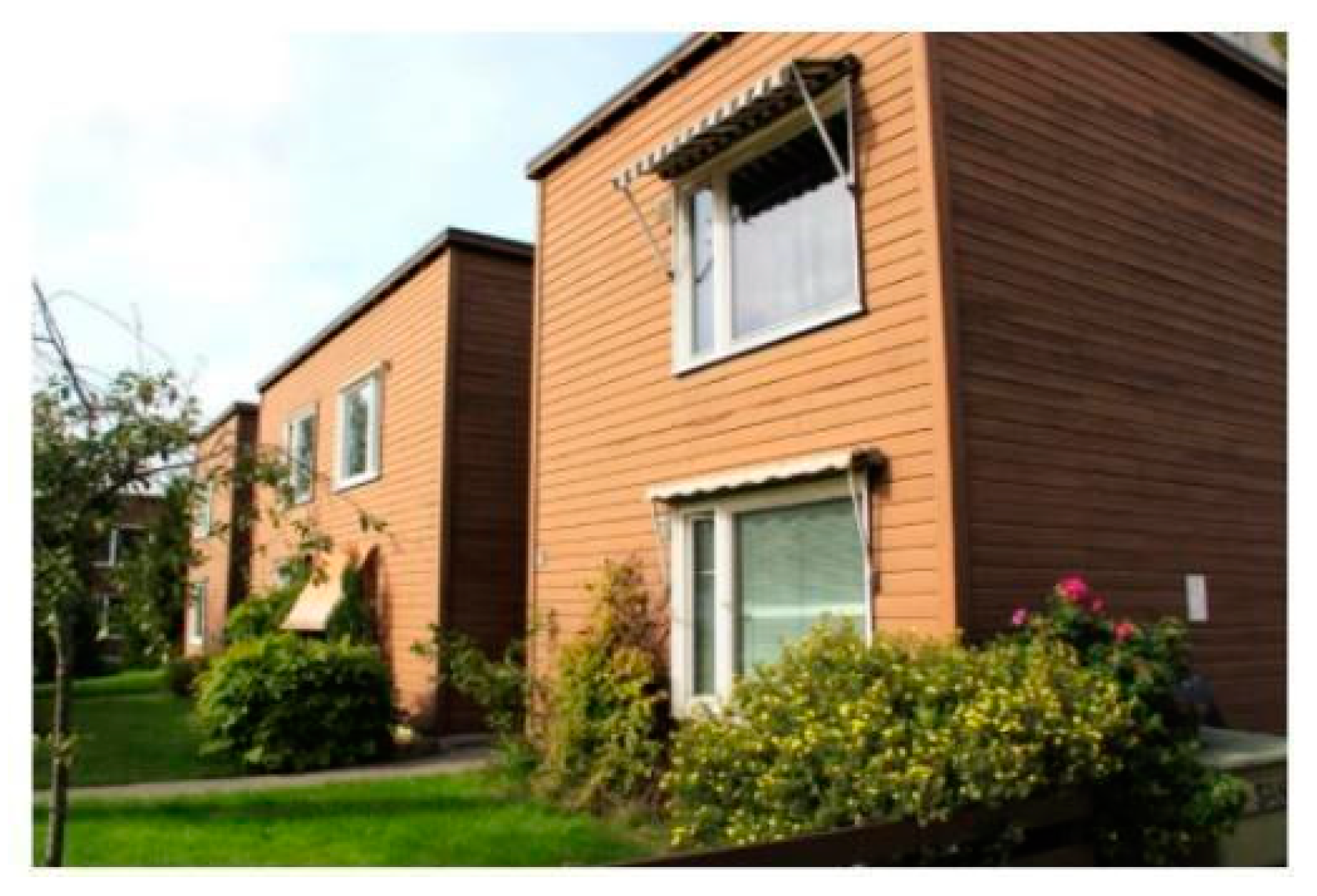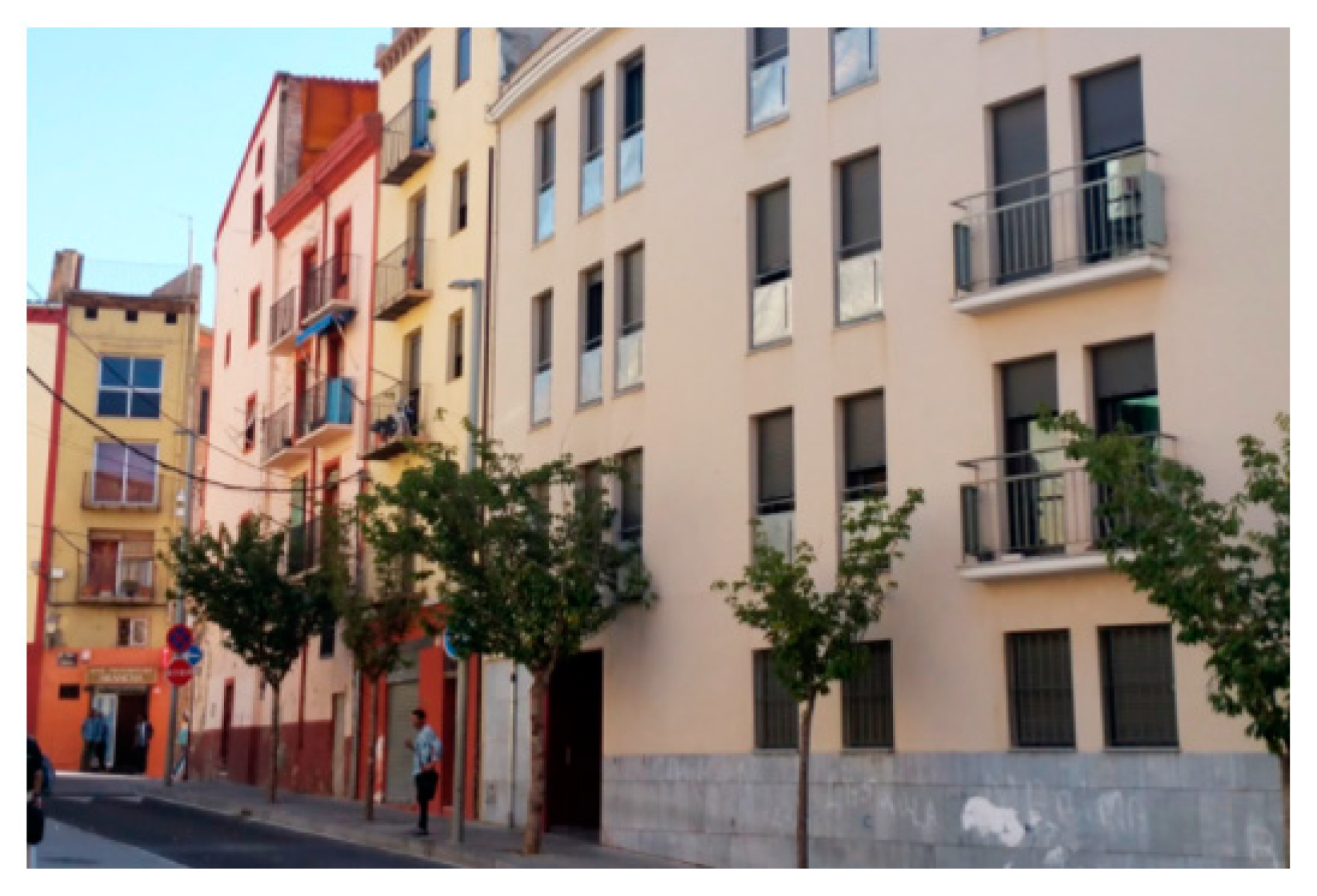4RinEU: Robust and Reliable Technology Concepts and Business Models for Triggering Deep Renovation of Residential Buildings in EU †
Abstract
:1. Introduction
- -
- Technical: lack of easy to apply, integrated, tailorable packages;
- -
- Social: no easy access to information on right behaviours, best practices and strategies for achieving environmental comfort and saving energy, lack of commitment of the users;
- -
- Credibility: uncertainties in term of actual performances and costs as well as responsibilities in case of delay or failures;
- -
- Financial: lack of access to affordable finance to carry out the renovation.
2. Research Pillars
- Technology development: to improve key passive, active, and control solutions, to optimize the integration and interactions among building components in dynamic contexts, to ensure a drastically reduction of net primary energy use (60 to 70% compared to pre renovation levels), ensuring high indoor environmental quality and architectural value, with reduction of lifecycle costs (15% compared to a typical renovation).
- Methodology development to support the design and implementation of robust, tailorable, cost-effective deep renovation packages in different boundary conditions, through multi-objective optimization, ensuring reduction of implementation time (by a factor of 2 compared to typical renovation through prefabrication and specific solutions for the management of the building site), and keeping the same performance level in the whole building lifecycle.
- Business models development to trigger EU building stock transformation, durably increasing the renovation rate up to 3% before 2020, as fixed by “renovate-Europe” campaign. This will be sustained by a reliable economic viability of deep renovation, quantified by an increased internal rate of return.
3. Expected Outcomes
3.1. Technologies
- reduce energy demand (1-Prefabricated Multifunctional Façade; 2-Comfort Ceiling Fan Smart Operation),
- improve energy efficiency (3-Plug&Play Energy Hub–PPEH; 4-Early-RENo),
- improve building operations (5-Sensible Building Data Handler), and
- reduce the construction waste (6-Strategies for Components End-Of-Life).
3.2. Methodologies
- better understand the context, potential savings and issues to be addressed during the renovation (7-Cost-Optimal Energy Audit),
- handle an aware and transparent design approach easily include 4RinEU deep renovation packages (8-Investor and Building User-Oriented Design Platform), and
- manage in a lean way the construction works reducing time and the associated failures (9-Deep Renovation Implementation Management).
3.3. Business Models
4. Demo Cases and Geocluster Approach
4.1. Norway
- Being in line with the CO2 emissions reduction targets of the city of Oslo
- Providing a good Indoor Air Quality
- Improving the quality of the envelope

4.2. Netherlands
- Adapting the building according to the needs of the users that are getting older
- Solving functional and safety problems
- Improving the comfort of the occupants
- Having exemplary role in the energy saving as public institution

4.3. Spain
- Reducing energy consumption to mitigate the fuel poverty issue
- Improving the comfort and the Indoor Air Quality of the occupants
- High replication potential

5. Expected Impacts and Future Developments
Acknowledgments
Author Contributions
Conflicts of Interest
References
- ©EEFIG (Energy Efficiency Financial Institutions Group). Energy Efficiency—The First Fuel for the EU Economy. How to Drive New Finance for Energy Efficiency Investments; European Union, 2014; Available online: http://www.unepfi.org/fileadmin/documents/EnergyEfficiencyInvestment.pdf (accessed on 26 October 2017).
- ©IEA (International Energy Agency), 2014. Capturing the Multiple Benefits of Energy Efficiency; Paris, France, 2014; © OECD/IEA, 9 rue de la Fédération 75739 Paris Cedex 15; ISBN 978 92 64 22072. Available online: http://www.iea.org/publications/freepublications/publication/Captur_the_MultiplBenef_ofEnergyEficiency.pdf (accessed on 25 October 2017).
- Project FP7 GE2O. Available online: http://www.geoclusters.eu/ (accessed on 16 October 2017).
- Project FP7 Inspire-Systemic Energy Renovation of Buildings. Available online: http://inspirefp7.eu/ (accessed on 16 October 2017).
© 2017 by the authors. Licensee MDPI, Basel, Switzerland. This article is an open access article distributed under the terms and conditions of the Creative Commons Attribution (CC BY) license (http://creativecommons.org/licenses/by/4.0/).
Share and Cite
Noris, F.; Pernetti, R.; Lennard, Z.; Signore, G.; Lollini, R. 4RinEU: Robust and Reliable Technology Concepts and Business Models for Triggering Deep Renovation of Residential Buildings in EU. Proceedings 2017, 1, 661. https://doi.org/10.3390/proceedings1070661
Noris F, Pernetti R, Lennard Z, Signore G, Lollini R. 4RinEU: Robust and Reliable Technology Concepts and Business Models for Triggering Deep Renovation of Residential Buildings in EU. Proceedings. 2017; 1(7):661. https://doi.org/10.3390/proceedings1070661
Chicago/Turabian StyleNoris, Federico, Roberta Pernetti, Zia Lennard, Gianluca Signore, and Roberto Lollini. 2017. "4RinEU: Robust and Reliable Technology Concepts and Business Models for Triggering Deep Renovation of Residential Buildings in EU" Proceedings 1, no. 7: 661. https://doi.org/10.3390/proceedings1070661
APA StyleNoris, F., Pernetti, R., Lennard, Z., Signore, G., & Lollini, R. (2017). 4RinEU: Robust and Reliable Technology Concepts and Business Models for Triggering Deep Renovation of Residential Buildings in EU. Proceedings, 1(7), 661. https://doi.org/10.3390/proceedings1070661





